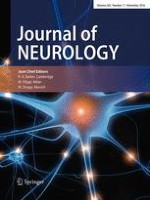Published in:

01-11-2016 | Original Communication
Retinal measures correlate with cognitive and physical disability in early multiple sclerosis
Authors:
Nabil K. El Ayoubi, Stephanie Ghassan, Marianne Said, Joelle Allam, Hala Darwish, Samia J. Khoury
Published in:
Journal of Neurology
|
Issue 11/2016
Login to get access
Abstract
Further studies are needed to determine the role of retinal optical coherence tomography (OCT) in non-optic neuritis (ON) eyes of patients with early MS. The objective of this study is to explore the relationship between retinal layers’ thickness and cognitive as well as physical disability in patients with the early RRMS. Participants in this cross-sectional study were adults with early RRMS, stable on interferon beta-1a, or fingolimod therapy, and without a history of ON in one or both eyes. Patients were evaluated clinically, underwent a battery of cognitive tests, and a retinal OCT scan which was also performed on a group of healthy age- and gender-matched controls. We studied 47 patients with RRMS, on interferon beta-1a (N = 32) or fingolimod (N = 15), and 18 healthy controls. Multivariate analyses controlling for age, disease duration, treatment, and education when exploring cognitive function, showed that pRNFL thickness correlated negatively with 9HPT (standardized Beta −0.4, p < 0.0001), and positively with SDMT (standardized Beta 0.72, p = 0.007). In patients with early RRMS without optic neuropathy, retinal thickness measures correlated with physical disability and cognitive disability, supporting their potential as biomarkers of axonal loss.